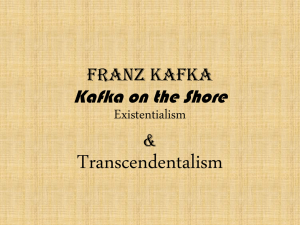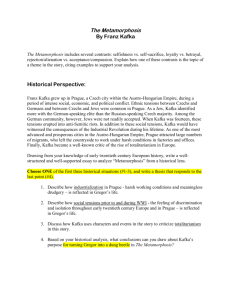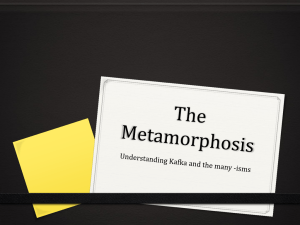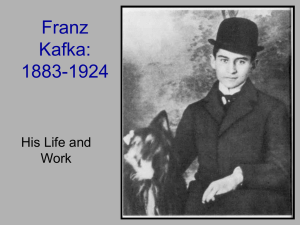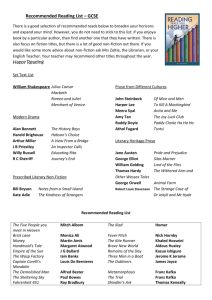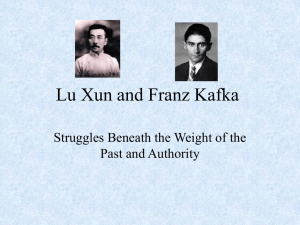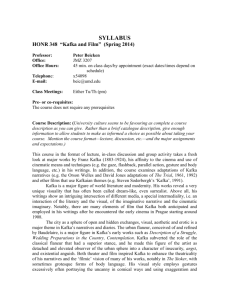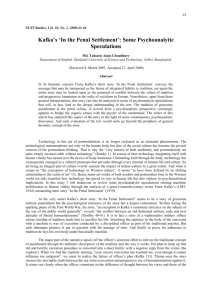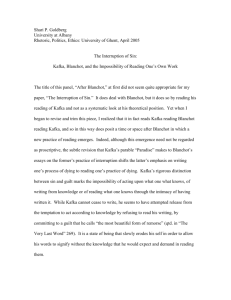Kafka and Stories of Mental Health
advertisement
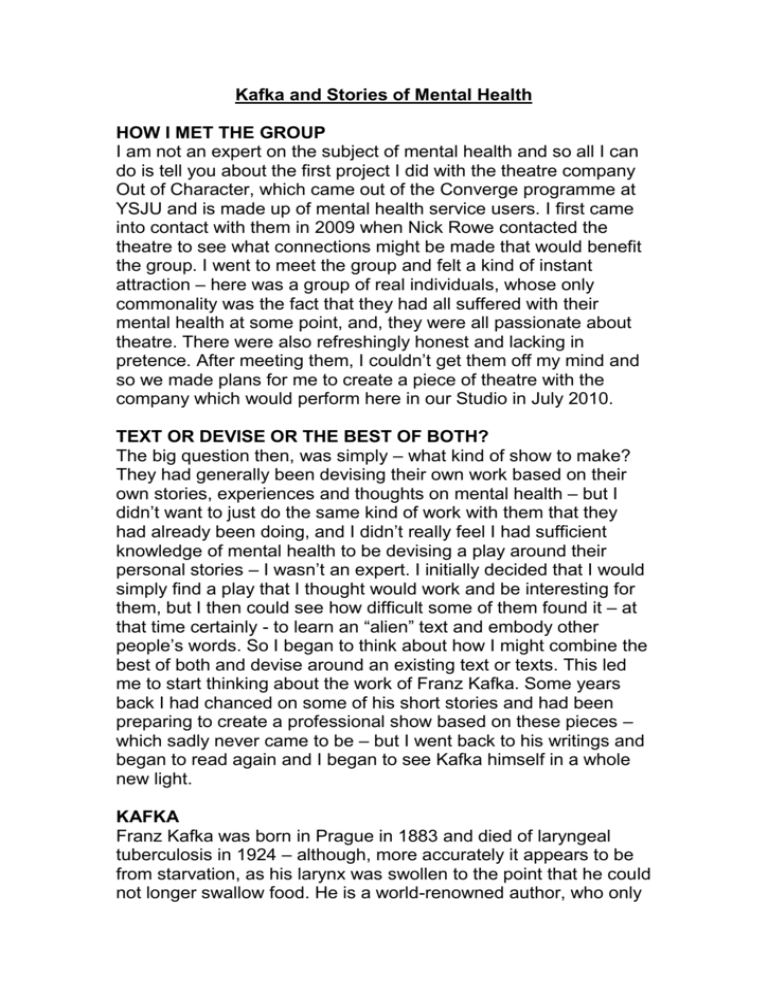
Kafka and Stories of Mental Health HOW I MET THE GROUP I am not an expert on the subject of mental health and so all I can do is tell you about the first project I did with the theatre company Out of Character, which came out of the Converge programme at YSJU and is made up of mental health service users. I first came into contact with them in 2009 when Nick Rowe contacted the theatre to see what connections might be made that would benefit the group. I went to meet the group and felt a kind of instant attraction – here was a group of real individuals, whose only commonality was the fact that they had all suffered with their mental health at some point, and, they were all passionate about theatre. There were also refreshingly honest and lacking in pretence. After meeting them, I couldn’t get them off my mind and so we made plans for me to create a piece of theatre with the company which would perform here in our Studio in July 2010. TEXT OR DEVISE OR THE BEST OF BOTH? The big question then, was simply – what kind of show to make? They had generally been devising their own work based on their own stories, experiences and thoughts on mental health – but I didn’t want to just do the same kind of work with them that they had already been doing, and I didn’t really feel I had sufficient knowledge of mental health to be devising a play around their personal stories – I wasn’t an expert. I initially decided that I would simply find a play that I thought would work and be interesting for them, but I then could see how difficult some of them found it – at that time certainly - to learn an “alien” text and embody other people’s words. So I began to think about how I might combine the best of both and devise around an existing text or texts. This led me to start thinking about the work of Franz Kafka. Some years back I had chanced on some of his short stories and had been preparing to create a professional show based on these pieces – which sadly never came to be – but I went back to his writings and began to read again and I began to see Kafka himself in a whole new light. KAFKA Franz Kafka was born in Prague in 1883 and died of laryngeal tuberculosis in 1924 – although, more accurately it appears to be from starvation, as his larynx was swollen to the point that he could not longer swallow food. He is a world-renowned author, who only became famous after his death, who’s own peculiar flavour of writing, has even spawned it’s own name “Kafkaesque” which derives from this sense of being unhoused, unable to find accommodation in a mysteriously antagonistic world, and is often used to describe surreal situations like those in his stories. The stories that he is most famous for are: The Trial, which deals with the character of Joseph K a man accused without ever knowing what for, treated as a criminal without a crime, and Metamorphosis, where the protagonist awakes to find himself transformed into a monstrous insect. But the themes of alienation, guilt, exclusion, self-loathing and self-lacerating pain both permeate his work and were evident in his own real life. Kafka was never formally diagnosed with a mental illness, but he was tormented by private fears and lonely anxieties which crippled his life. Kafka said himself : IT IS THROUGH WRITING THAT I KEEP A HOLD ON LIFE. This seemed to me to resonate strongly with what many of the Out of Character group and indeed, members of the wider Converge arts courses, would say was that being involved in the arts was giving them a grip on themselves - one member even described the sessions as giving him something to live for. And this idea led to the show Tales from Kafka. WHAT ARE THE STORIES ABOUT? KAFKA’S WORK DEFIES LITERAL TRANSLATIONS So I started to read through Kafka’s short stories and quickly jettisoned the longer stories I had originally been drawn to (Investigations of a Dog and The Judgement) and became more and more fascinated by some of the more obscure pieces of writing and fragments of ideas and stories. If you have never read these, I urge you to take a look, as they make fascinating reading. They sometimes have the quality of dreams, that have simply been recorded, and are both bizarre, and yet hold a brilliant and perceptive mirror up to nature, using unforgettable imagery. I often hear people talk about Kafka’s stories and they say things like: “oh yes, The Trial, that’s the one that is an allegory about blah, blah, blah, and Metamorphosis, that is actually about blah!” (I’ll leave you to define the blahs.) But Kafka’s work defies easy literal translations, his stories use highly original symbols that speak to us on many different levels, and – not unlike fairytales and great works of art – hold different narratives for different people at different times. Like our dreams, the stories don’t always make sense when we attempt to translate them into a linear narrative, but the key images we remember have impact and resonate with our own sense of what it means to be human, and our emotional or spiritual experiences of the world. For example, one story that I included in the piece we finally made together was simply called “Unhappiness”, and begins like this: When it was becoming unbearable – once toward evening in November – and I ran along the narrow strip of carpet in my room as on a racetrack, shrank from the sight of the lit-up street, then turning to the interior of the room found a new goal in the depths of the looking-glass and screamed aloud, to hear only my own scream which met no answer nor anything that could draw its force away, so that it rose up without check and could not stop even when it ceased being audible, the door opened toward me…..and like a small ghost a child blew in from the pitch-dark corridor, and stood a tiptoe on a floor board that quivered imperceptively… The man proceeds to have a surreal conversation with the ghost, who reminds him how close she is to his own nature, until finally he leaves and meets a neighbour and tells him he has a ghost in his house – which they joke about together and neither of them quite believe – although the man warns the neighbour not to even think about stealing his ghost, and then returns forlornly to his room – trapped even though he would rather have gone out. There is no straightforward translation of meaning for this story, but the heart of it seems to lie in what the man says to the neighbour that being scared of the ghost is only a secondary fear: The real fear is a fear of what caused the apparition. And that fear doesn’t go away. I have it fairly powerfully inside me now. The story could be interpreted in many ways, but the basic image of a ghost being a manifestation of something inexplicable, to be feared, which is clearly related and connected to yourself, which has sprung from your own screaming unhappiness and which others don’t believe, and even joke about, but which is very real to you and which keeps you trapped and isolated however much you want to escape from it, is a pretty powerful analogy for the experiences of someone suffering with their mental health. PROCESS AND WHAT THE PLAY NEEDED So, I began selecting stories and bringing them to the group and we would read them discuss what we thought they meant, or what they made us think of, and then we would split into 2 groups and create a dramatisation of them, highlighting whatever we found most arresting in the writing, or the things that the actors most clearly identified with. I began to script some of the stories off the back of this, but I knew I needed a stronger backbone to the piece as a collection of stories – some kind of framing device was needed. Two pieces came to light that helped me do this. The first was called At Night: Deeply lost in the night. Just as one sometimes lowers one’s head to reflect, thus to be utterly lost in the night. All around people are asleep. It’s just play acting, an innocent selfdeception, that they sleep in houses, in safe beds, under a safe roof, stretched out or curled on mattresses, in sheets, under blankets; in reality they have flocked together as they had once upon a time and again later in a deserted region, a camp in the open, a countless number of men, an army, a people, under a cold sky on cold earth, collapsed where once they had stood, forehead pressed on the arm, face to the ground, breathing quietly. And you are watching, are one of the watchmen, you find the next one by brandishing a burning stick from the brushwood pile beside you. Why are you watching? Someone must watch, it is said. Someone must be there. Whatever Kafka had intended to convey with this story, I can’t say, I can only tell you what it created for me. I saw the characters from the other stories as a group of restless, sleepless sleepers, kept awake by their thoughts and fears, pretending to sleep, whose stories or possibly dreams or nightmares are what we witness on stage. They believe they are alone, and are not conscious of the others around them, who are going through similar things, and are unaware that the idea that the rest of the world is safe and sound asleep in their beds while they toss and turn is an illusion. And in our play, I thought, we would see these restless sleepers flocked together, each sleeper illuminated by a burning stick – or a theatre spotlight in more mundane terms - as we hear their story. So this was the framing device I decided to use. WHY ARE YOU WATCHING? But I was also very struck by the line: And you are watching, and why are you watching? Which I felt as a direct address to us as an audience. Why are you watching? It seemed to me to hold the question, why are we so fascinated with madness? And it was a question I needed to ask myself. Why do we want to watch it so much – madness is a huge ubiquitous theme in theatre, and there is barely a play that’s ever been written that doesn’t touch on mental health in some shape or form. Why do we want to watch? And why just watch? Why are we content to be passive bystanders to those in need, instead of involving ourselves in the lives of others, however messy. It felt like this line needed to be a gentle provocation to the audience that might come and watch us. And yet the story concludes with Someone must watch, it is said. Someone must be there. In some ways I felt the act of witnessing this company tell these stories, was in itself an important one. A group of people many of whom had dropped off the edge of society at points in their lives, whose voices were inaudible in their community, but who would connect their voices and experiences to a literary giant, and be listened to, given place and respect. JOSEPH K The other piece that I found that helped me create more of a backbone to the piece was discovering that Kafka’s famous story The Trial, was not the only time he had written about the character Joseph K, there is a short story, simply entitled A Dream, which begins with the words: Joseph K was dreaming. In the dream he finds himself in a graveyard and discovers an artist engraving a tombstone with Here Lies Joseph K. he digs down into the earth to create a great hole and then sinks into it in relief wafted onto his back by a gentle current. It ends with the words: Enchanted by the sight, he woke up. I was intrigued that this famous character had another story attached to him and curious as to what was the story of this man’s life leading up to this point that he was so delighted to sink into his own grave – even in his dreams. This gave me a very clear central character who could be one of the sleepers and who’s journey might thread through the whole play, and as I read other fragments, I found several other sections that seemed to contribute to an interesting narrative for Joseph K, ending with his final moments in the grave – although of course that wasn’t really the end of the story, because it says he wakes up. So was a more positive ending possible? So I had a framing device and a good narrative backbone in order to create a play full of stories dealing with themes of guilt, persecution, loneliness and failure to cope, themes common to Kafka, common to mental health service users and indeed highly recognisable to most of us, which the Out of Character actors were excited and inspired to tell. There is, however, one other less prominent but still reoccurring theme in Kafka’s work: hope for new life and a sense of personal remaking. That the play should hold hope too, was very important, and inspired by the things the actors had told me about how important the company was and how much the other people in it meant to them and were a support to them, I decided to finish the play with the sleepers waking up and noticing the other sleepers, simply recognising that they were not alone and finding a comfort and support in that. So I wrote the play, partly from the work that we had devised together, partly from my own thoughts and ideas, but all inspired by the duality of Kafka’s voice and the actors voices. I scripted the roles with them in mind, and cast them according to the parts I felt they identified with and were drawn to. I didn’t have huge amounts of time to get to know them, so I had to work from my gut instinct as to who would fit best where. I never once asked them about their past illnesses or diagnoses – I never felt I had the right to ask, and didn’t want to look at them like a set of pigeon holes. Each had a unique voice and unique experiences and I tried to cast them where I felt they fitted in this unique set of stories. Interestingly, one of the actors after the first night said to me – You had us sussed. Oh yeah, you had our number alright – I took this to mean that I had connected most of the group quite well to stories that they related to, however weird and wonderful they were on the surface – and some of them were really weird and wonderful like the one about the man who comes home from work one day to find two balls independently bouncing in his flat, that won’t go away or stop bouncing so he has to try to hide or get rid of them. A weird story, and yet again, without pasting a literal interpretation on to it, felt quite appropriate to the actor who played him, and was immediately the part he wanted to play. Quite late in the progress I tried to do some character work with the cast to help them develop a stronger sense of who they were, but largely the descriptions of their character were just versions of themselves – in one or two cases, even down to their imagined occupation. The actors were very much connecting and taking themselves into the characters and fusing their voices and experiences with them, and thereby telling some of their own story through a piece that had a wider universal appeal and recognition. Some actors perhaps were more fitted to do this than others – although, again, I didn’t know it at the time. Back this last summer we started working on a new version of the play called More Tales from Kafka – expanded and partially recast as we have a different company of actors this time. When I discussed with each of the actors from the original piece, whether they wanted to play the same parts again – they all said yes with the exception of one man, who had played a character in the original version who is crippled by anxiety, self-doubt and lack of confidence, who says he is “Completely unsure of my footing in this world, in this town, in my family.” He desperately wants a relationship but always fails, and is terrified of remaining a bachelor – very like Kafka himself, who never managed to get the marriage that he so wanted. This actor kept saying he was happy to try something different this time – which surprised me as he’d played it brilliantly first time round and really invested in it. Then of course the penny dropped, this particular actor was just about to get married. Something hard to imagine 3 years before. His circumstances had so much moved on that he could no longer relate to that voice. In fact, after his wedding, he decided to leave the group as he felt he had a lot going on in his life. So would it have been better – as perhaps the most immediate and sometimes what is perceived as being the “correct” choice would have been – to have created a piece simply out of their own personal stories? Or was it better to allow them to connect to a more universal voice that recognises the fears, struggles and loneliness of human beings generally. To create a sense of commonality between audience and actor to promote empathy and understanding, rather than you sit there and listen to our stories and how hard it has been for us. There is something about moving away from the personal that allows (in my opinion) a greater communication and connection. The poet and playwright T.S. Eliot (who’s wife incidentally suffered from mental illness) was quite critical about writing that was solely about personal emotional expression – he believed that it is the changing or alchemising of a personal emotion into something altogether more universal, even objective, that was important, and that drama is actually looking for something external to an inner personal emotion on which to hang that feeling and change it into something much more than an individual emotion. Eliot described it quite eloquently when he said: Shakespeare, too, was occupied with the struggle…to transmute his personal and private agonies into something rich and strange, something universal and impersonal. This is what I believe Out of Character and myself did in creating Tales from Kafka – we turned our personal and private agonies through the extraordinary conduit of Kafka – into something rich and strange. Finish with clip of the beetle speech from the dress rehearsal of Tales From Kafka.
